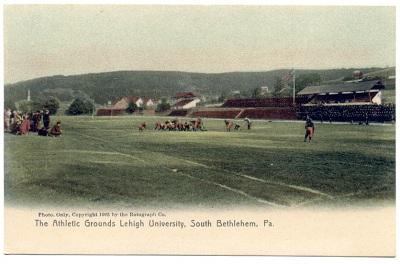
Architect: A. W. Leh and Henry F. Hornbostel
Patron: Charles L. Taylor
Dates: 1913-1914, 1976 Remodel, 19 November 1987 Last Game Played in Taylor Stadium, 1989 Remodel
Type: Athletic, Academic
By 1913 Lehigh University was quickly outgrowing the limited space within Coppee Hall, the original university gymnasium, as the popularity and success of Lehigh Athletics were rapidly increasing. Prominent trustee John Fritz died in 1913, willing the entirety of his estate to another Board of Trustee member and Lehigh alum, Charles “Charley” L. Taylor. With this news, Taylor (namesake of Taylor Residence Hall) approached Lehigh with a gift of $100,000 and the plans for a new gymnasium and renovations for the football stadium.
Taylor wanted to ensure that Lehigh students had a say in the planning of the new facilities. The blueprints of the proposed project were posted in various buildings around campus, providing the opportunity to comment and contribute ideas. The student body passed the resolution for the project in February 1913, and construction for Taylor Gymnasium began in September under the direction of New York City architect, Henry F. Hornbostel and local architect, A.W. Leh. The original plan called for an ample-sized basketball court and a 75 ft long indoor swimming pool on the lower level, with locker rooms, offices, trophy rooms, and game rooms located on the upper levels. The current entrance to Taylor Gymnasium was originally a barrel vaulted passage way to the athletic fields beyond. The passage was converted into the entrance to the gym in 1951. The gymnasium was to be completed by November 1913 for the Lehigh-Lafayette game; however, the lack of funds and “unforeseen difficulties” delayed the completion date. With the pressure of the approaching basketball season—the second intercollegiate season for Lehigh—Taylor Gymnasium was fully opened in January 1914.
In conjunction with Taylor Gymnasium, renovations were being made to the stadium, which included a new field house, new concrete grand stands, a new track, practice fields for football, baseball, and lacrosse, and addressing general issues of drainage and space. The stadium upgrades were estimated to cost $90,000; however, the architects quickly realized that those funds would not stretch far enough. Construction of the new grand stands had to be halted, while a fundraising campaign was launched. Students, alumni, and local clubs pledged to donate sections of the grandstands- a successful approach that enabled the completion of the 20,000 seat stadium. Additionally, Bethlehem Steel contributed to the construction of the stadium- supplying labor, supplies, and further donations of seating sections. A portion of the construction was completed for the 1913 Lehigh-Lafayette game, but worked continued on the new stadium until 1916. The upper fields were open for use in February of 1914 for lacrosse games, and the track was open for use that fall. The stadium also included a press box which allowed telegraphs to be relayed immediately to not only local newspapers but also Philadelphia and New York newspaper offices.
In March of 1914, President Drinker once again announced “a splendid donation” from Charles Taylor, who donated additional funds for a field house to be erected next the new gymnasium to provide space for exercise classes and non-varsity or visiting athletes. The architects were to remain the same. A subterranean tunnel was constructed as a passage between new field house and the southwest corner of the athletic field.
On October 17th, 1914 the Taylor athletic complex had its formal grand opening. The day would come to be known as “Taylor Day” in appreciation for the glory that Charles Taylor had brought to Lehigh and the athletic program.
In 1986, under President Likins, plans were revealed for the new athletic complex to replace the now 70 year-old Taylor Stadium. The new stadium was to be located on the Homer Laboratories land in Saucon Valley, a tract which the university purchased from Bethlehem Steel in 1987. Plans were passed for the new stadium in 1987, and Taylor Stadium saw its last season that year. The Brown and White articles indicate that “it was with few cheers” that the athletic fields were moved to Goodman Stadium where “Le-Laf would never quite be the same.” As early as 1986, there was already the plan for the future space to hold a College of Business and arts center. Rauch Business Center was established in 1990 and Zoellner Arts Center in 1997.
A remnant of the once third oldest stadium remains as reminder of the site’s long history as an athletic field. The arch from the main entrance of Taylor Stadium became part of the formal landscape of the Rauch-Zoellner complex.
(Text by Stephanie Riker)
Taylor Gymnasium was made possible thanks to the generous donation of $100,000 from alumni, Charles Taylor, who graduated Lehigh as valedictorian of his class, with a Bachelor of Science degree in
When most talk about the “Lehigh Lafayette Rivalry,” they are referring to the football game. Few know that the rivalry exists in more than in just the sport of football.
Women were first admitted to Lehigh University in 1971. Shortly after, women integrated themselves into campus by joining organizations and forming sports teams.
Still Looking for You
Lehigh University
Bethlehem, PA 18015

27 Memorial Drive West, Bethlehem, PA 18015
